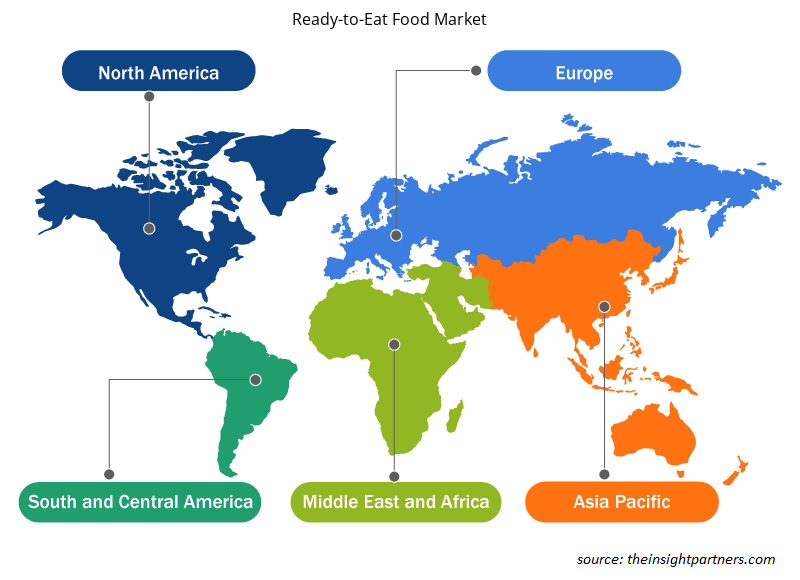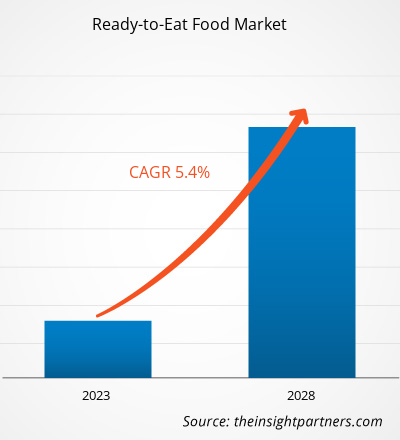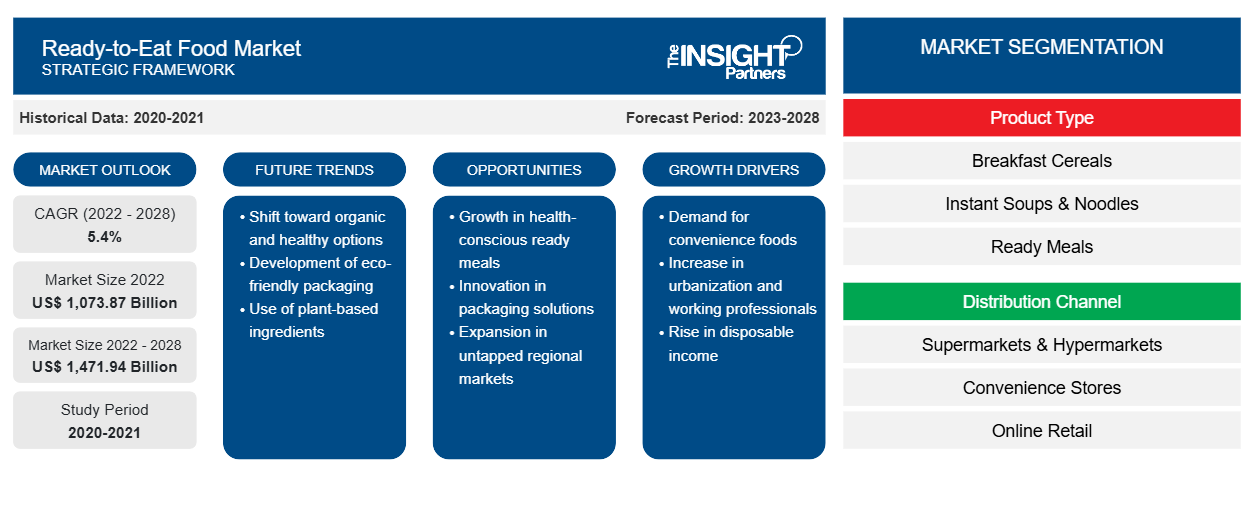[Informe de investigación] Se proyecta que el mercado de alimentos listos para el consumo alcance los 1.471,94 mil millones de dólares en 2028, frente a los 1.073,87 mil millones de dólares en 2022. Se espera que crezca a una CAGR del 5,4 % entre 2022 y 2028.
Los alimentos listos para consumir consisten en diversos alimentos procesados y envasados que se pueden consumir sin preparación adicional. Los ingredientes se lavan, se cocinan, se procesan y se envasan en recipientes para el consumo directo. Algunos tipos comunes de alimentos listos para consumir incluyen sopas instantáneas, productos horneados, postres y comidas preparadas. Estos productos están enriquecidos con diversos extractos, ácidos, sabores, edulcorantes , antioxidantes y conservantes. Ofrecen una inmensa comodidad al consumidor al mismo tiempo que ayudan a reducir el tiempo de preparación de las comidas y brindan una vida útil más larga de los productos, rentabilidad y un deterioro mínimo.
En 2020, la región de Asia Pacífico tuvo la mayor participación en el mercado de alimentos listos para consumir , mientras que se espera que otras regiones en desarrollo, como Oriente Medio y África, crezcan significativamente en el período de pronóstico. Los actores clave que operan en el mercado de alimentos listos para consumir están expandiendo sus operaciones en Asia Pacífico debido al aumento de la población activa y los estilos de vida agitados de las personas en los países en desarrollo. Las personas optan cada vez más por consumir alimentos para llevar o fuera del hogar.
Además, numerosos estudios han demostrado que las empresas transnacionales de alimentos y bebidas han moldeado los sistemas alimentarios y el consumo general de maneras que modifican la disponibilidad, la conveniencia, el precio y, en última instancia, el consumo de alimentos procesados. El crecimiento del mercado de alimentos listos para el consumo se ha observado de forma destacada en los países de ingresos medios.
Personalice este informe según sus necesidades
Obtendrá personalización en cualquier informe, sin cargo, incluidas partes de este informe o análisis a nivel de país, paquete de datos de Excel, así como también grandes ofertas y descuentos para empresas emergentes y universidades.
-
Obtenga las principales tendencias clave del mercado de este informe.Esta muestra GRATUITA incluirá análisis de datos, desde tendencias del mercado hasta estimaciones y pronósticos.
Impacto de la pandemia de COVID-19 en el mercado de alimentos listos para consumir
La pandemia de COVID-19 planteó desafíos sin precedentes para muchos sectores a principios de 2020. Los confinamientos, las restricciones fronterizas, las prohibiciones de viaje, la interrupción de la fabricación y otras medidas de seguridad implementadas por los gobiernos según las directrices de la OMS y los ministerios de salud nacionales obstaculizaron las operaciones de fabricación. Por otro lado, el brote de COVID-19 afectó positivamente al mercado de alimentos listos para el consumo, ya que los consumidores y los minoristas estaban acumulando productos alimenticios de conveniencia con estantes más largos. Además, los consumidores que buscaban alimentos y bebidas envasados más saludables para reforzar la inmunidad se alarmaron por el impacto de COVID-19. Entonces, los fabricantes de productos listos para el consumo se centraron en productos saludables y nutritivos con enriquecimiento de proteínas y otros valores nutricionales, lo que estimuló la demanda de productos alimenticios listos para el consumo durante la pandemia.Lockdowns, border restrictions, travel bans, manufacturing discontinuation, and other safety measures rolled out by governments as per the guidelines of the WHO, and national health ministries hampered the manufacturing operations. On the other hand, the COVID-19 outbreak positively impacted the ready-to-eat food market as consumers and retailers were stockpiling convenience food products with longer shelves. Also, consumers looking for healthier packaged food and beverage products to boost immunity were alarmed by the COVID-19 impact. Then, manufacturers of RTE products focused on healthy and nutritious products with enrichment of proteins and other nutritional values, which stimulated the demand for ready-to-eat food products during the pandemic.
Perspectivas de mercado
La fuerte preferencia por los alimentos preparados entre los millennials impulsa el crecimiento del mercadoMillennials Drives Market Growth
El consumo de productos alimenticios de alta calidad está aumentando, lo que actualmente es una de las mayores tendencias en la industria alimentaria. Los alimentos de conveniencia, como los productos listos para el consumo, permiten a los consumidores ahorrar tiempo y esfuerzo asociados con la preparación y cocción de las comidas, el consumo y las actividades posteriores a las comidas. Se dice que las fuentes del desarrollo de este segmento de alimentos incluyen la cantidad de cambios sociales, en particular el número cada vez mayor de hogares más pequeños y el aumento de la población de millennials en todo el mundo. Debido a los agitados horarios de trabajo de los millennials, prefieren ser eficientes con su tiempo en lugar de malgastarlo en tareas tediosas. Es más probable que gasten su dinero en conveniencia. Por lo tanto, prefieren cada vez más productos listos para el consumo, como productos horneados, bocadillos y productos lácteos, lo que impulsa aún más el mercado de alimentos listos para el consumo.millennials, they prefer to be efficient with their time rather than wasting it on tedious tasks. They are more likely to spend their money on convenience. Thus, they increasingly prefer RTE products, such as baked products, snacks, and dairy products, further driving the ready-to-eat food market.
Información sobre el tipo de producto
Según el tipo de producto, el mercado de alimentos listos para comer se segmenta en cereales para el desayuno, sopas y fideos instantáneos, comidas preparadas, bocadillos, productos horneados y dulces, y otros. Se proyecta que el otro segmento de alimentos listos para comer registre la mayor participación durante el período de pronóstico. Otros tipos incluyen productos lácteos, postres, cremas para untar, salsas y aderezos. Los productos lácteos listos para comer incluyen helado, yogur, leche saborizada envasada y queso. Los consumidores conscientes de la salud consumen principalmente productos lácteos, ya que los productos lácteos regulares mejoran la salud de los huesos y los intestinos y reducen los riesgos de enfermedades cardiovasculares (ECV) y diabetes tipo 2. La popularidad de las salsas y aderezos procesados y envasados creció a medida que las personas cambiaron las formas de vida tradicionales y adoptaron un estilo de vida moderno, lo que impulsó el crecimiento del mercado de alimentos listos para comer.CVDs) and type 2 diabetes. The popularity of processed and packaged sauces and dips grew as people switched from traditional ways of living and adopted a modern lifestyle, fueling the growth of ready-to-eat food market.
Perspectivas regionales sobre el mercado de alimentos listos para el consumo
Los analistas de Insight Partners explicaron en detalle las tendencias y los factores regionales que influyen en el mercado de alimentos listos para consumir durante el período de pronóstico. Esta sección también analiza los segmentos y la geografía del mercado de alimentos listos para consumir en América del Norte, Europa, Asia Pacífico, Oriente Medio y África, y América del Sur y Central.

- Obtenga los datos regionales específicos para el mercado de alimentos listos para el consumo
Alcance del informe sobre el mercado de alimentos listos para el consumo
| Atributo del informe | Detalles |
|---|---|
| Tamaño del mercado en 2022 | US$ 1.073,87 mil millones |
| Tamaño del mercado en 2028 | US$ 1.471,94 mil millones |
| CAGR global (2022-2028) | 5,4% |
| Datos históricos | 2020-2021 |
| Período de pronóstico | 2023-2028 |
| Segmentos cubiertos |
Por tipo de producto
|
| Regiones y países cubiertos |
América del norte
|
| Líderes del mercado y perfiles de empresas clave |
|
Densidad de actores del mercado de alimentos listos para el consumo: comprensión de su impacto en la dinámica empresarial
El mercado de alimentos listos para consumir está creciendo rápidamente, impulsado por la creciente demanda de los usuarios finales debido a factores como la evolución de las preferencias de los consumidores, los avances tecnológicos y una mayor conciencia de los beneficios del producto. A medida que aumenta la demanda, las empresas amplían sus ofertas, innovan para satisfacer las necesidades de los consumidores y aprovechan las tendencias emergentes, lo que impulsa aún más el crecimiento del mercado.
La densidad de actores del mercado se refiere a la distribución de las empresas o firmas que operan dentro de un mercado o industria en particular. Indica cuántos competidores (actores del mercado) están presentes en un espacio de mercado determinado en relación con su tamaño o valor total de mercado.
Las principales empresas que operan en el mercado de alimentos listos para consumir son:
- Nestlé SA
- Marcas Conagra Inc.
- La empresa Kraft Heinz
- Compañía: General Mills Inc.
- COMPAÑÍA DE SOPAS CAMPBELL
Descargo de responsabilidad : Las empresas enumeradas anteriormente no están clasificadas en ningún orden particular.

- Obtenga una descripción general de los principales actores clave del mercado de alimentos listos para consumir
Información sobre el canal de distribución
Según el canal de distribución, el mercado de alimentos listos para comer se ha segmentado en supermercados e hipermercados, tiendas de conveniencia, venta minorista en línea y otros. Se proyecta que el segmento minorista en línea registre la CAGR más alta en el mercado de alimentos listos para comer durante el período de pronóstico. La venta minorista en línea ofrece una experiencia de compra conveniente para los usuarios, seguida de una entrega de productos simplificada. Las tiendas minoristas en línea ofrecen una amplia gama de productos con grandes descuentos; además, los consumidores pueden comprar cómodamente los productos deseados de forma remota.
Los actores clave que operan en el mercado de alimentos listos para consumir son Nestlé SA; Conagra Brands Inc.; The Kraft Heinz Company; General Mills Inc.; CAMPBELL SOUP COMPANY; MTR Foods Pvt Ltd.; Hormel Foods Corporation; Tyson Foods, Inc.; JBS SA; y The Kellogg Company. Estos actores se dedican al desarrollo de productos con riesgos reducidos para la salud para satisfacer las tendencias emergentes de los consumidores y cumplir con los marcos regulatorios. Están involucrados en fusiones y adquisiciones, expansiones comerciales y asociaciones para expandir su participación de mercado.
Informe Destacado
- Tendencias progresivas de la industria en el mercado de alimentos listos para consumir que ayudarán a los actores a desarrollar estrategias efectivas a largo plazo
- Estrategias de crecimiento empresarial adoptadas para asegurar el crecimiento en los mercados desarrollados y en desarrollo
- Análisis cuantitativo del mercado de alimentos listos para consumir de 2019 a 2028
- Estimación de la demanda mundial de alimentos listos para el consumo
- Análisis de las cinco fuerzas de Porter para ilustrar la eficacia de los compradores y proveedores que operan en la industria
- Avances recientes para comprender el escenario competitivo del mercado
- Tendencias y perspectivas del mercado y factores que rigen el crecimiento del mercado de alimentos listos para el consumo
- Asistencia en el proceso de toma de decisiones destacando las estrategias de mercado que sustentan el interés comercial, lo que conduce al crecimiento del mercado.
- Tamaño del mercado de alimentos listos para el consumo en varios nodos
- Descripción detallada y segmentación del mercado y la dinámica de la industria de productos RTE
- Tamaño del crecimiento en varias regiones con oportunidades de crecimiento prometedoras
- Análisis histórico (2 años), año base, pronóstico (7 años) con CAGR
- Análisis PEST y FODA
- Tamaño del mercado, valor/volumen: global, regional y nacional
- Industria y panorama competitivo
- Conjunto de datos de Excel
Informes recientes
Informes relacionados
Testimonios
Razón para comprar
- Toma de decisiones informada
- Comprensión de la dinámica del mercado
- Análisis competitivo
- Información sobre clientes
- Pronósticos del mercado
- Mitigación de riesgos
- Planificación estratégica
- Justificación de la inversión
- Identificación de mercados emergentes
- Mejora de las estrategias de marketing
- Impulso de la eficiencia operativa
- Alineación con las tendencias regulatorias























 Obtenga una muestra gratuita para - Mercado de alimentos listos para comer
Obtenga una muestra gratuita para - Mercado de alimentos listos para comer